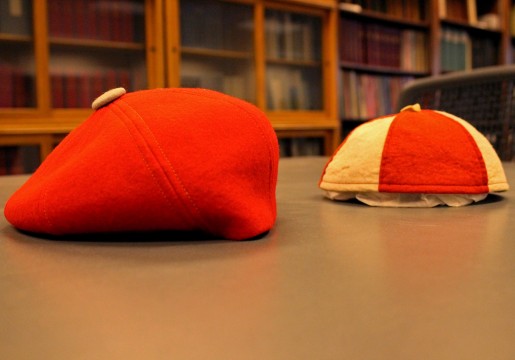
Freshman men were required to wear beanies as a part of initiation into the university around 100 years ago. This tradition lasted up until about the mid-20th century. Credit: Leisa DeCarlo / Lantern reporter
Freshmen Buckeyes were required to put on another hat besides their thinking cap back in the day.
Just over 100 years ago, the tradition of the class cap was born, and all freshmen men were required to wear a class cap or beanie as initiation into the university.
According to OSU archives, the cap tradition began in 1912 and its look changed throughout its lifetime at OSU, including styles such as “jockey-style,” the “knitted toboggan” and the “peanut-shaped skull cap.”
It served to visually distinguish the freshmen from their OSU peers and to perpetuate a practice of school spirit among first-year students, said Lindy Smith, OSU research services archivist.
“The idea of identity as a class was a much bigger deal when class sizes were smaller,” Smith said.
Although they were not required to wear a beanie, female freshmen were required to wear a gray class pin printed with a scarlet letter “F,” Smith said.
“It was a way of bonding the freshmen with each other because then you could immediately see who was as new to campus as you were,” Smith said.
According to OSU archives, the task of enforcing the OSU freshmen cap rule was a responsibility of the 14 members of the then-junior men’s honorary Bucket & Dipper. At the time, the Student Senate president of OSU authorized the honorary’s men to carry out punishment for breaking the rule. A freshman found without his cap might be forced to scrub the entire Long Walk of the Oval on his hands and knees or could even be thrown into Mirror Lake, Smith said.
Freshmen had to wear the beanies up until around Thanksgiving, where they could then take a break, Smith said. They then had to resume wearing the beanies until about June.
At the end of the school year, freshmen would gather at a “Cap Bonfire” to burn their beanies in celebration of joining the ranks of fellow upperclassmen, according to OSU archives.
Yet, the tradition of the beanie was not original to OSU — rather, at least 12 of the current 14 Big Ten universities required freshman men to wear beanies, Smith said.
In many cases the beanies were green to represent “new and inexperienced” students. But Smith said the caps worn at OSU were different.
“At Ohio State, they were scarlet or scarlet and gray … although they might have been white at one time,” Smith said.
According to the archives, the tradition eventually died down during the mid-20th century to which some freshmen said they are glad.
“I would feel like I was in the ‘The Scarlet Letter,’” said Carly Polcyn, a first-year in biology. “I feel like walking around in groups and having to look at maps all the time is enough of an indicator without a beanie.”
Fourth-year in computer science and engineering Brett Koenig agreed that even though the beanies are no longer a requirement in 2014, there are many ways that OSU upperclassmen can easily spot a freshmen.
“Two signs for me are if you’re walking in a herd of people and the lanyards,” Koenig said.
Jackson Frazier, a third-year in math and economics, concurred.
“I think it’s very obvious at the beginning of the semester. They’re looking at their phones trying to figure out where they are,” Frazier said. “They look hopeful. They haven’t been burnt out by college yet.”
Others said they wouldn’t mind wearing the pin.
“I think I would be self-conscious,” said Ellie Coggins, a first-year in environment, economy, development and sustainability. “But I could do a pin.”
Although Smith said the tradition would be difficult to enforce in 2014, she said it’s important to remember as a part of OSU’s history.
“I think it gives you a sense of identity as part of a larger university,” Smith said. “Traditions have to start somewhere. It’s part of the identity of OSU.”


